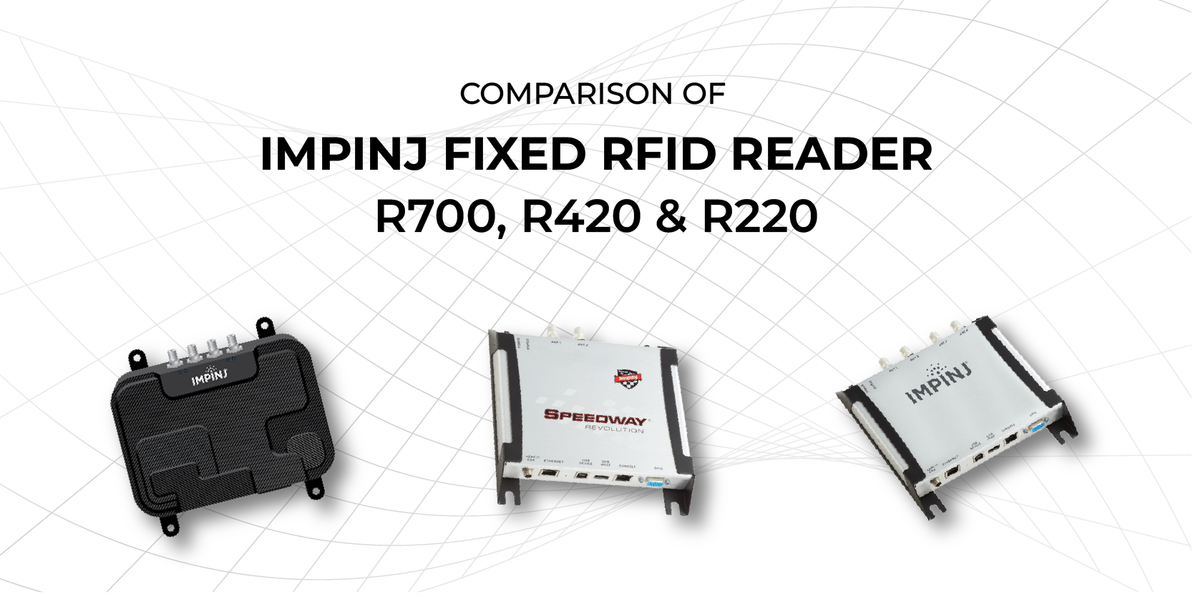Comparison of Impinj Fixed RFID Readers: R700, R420, and R220
Introduction
In the world of supply chain management, retail inventory, healthcare, and industrial automation, RFID (Radio Frequency Identification) plays a pivotal role in providing real-time visibility, efficiency, and automation. Among the leading players in the RFID hardware market, Impinj stands out with its reliable, high-performance fixed RFID readers. However, with multiple models available—R700, R420, and R220—choosing the right reader can be challenging.
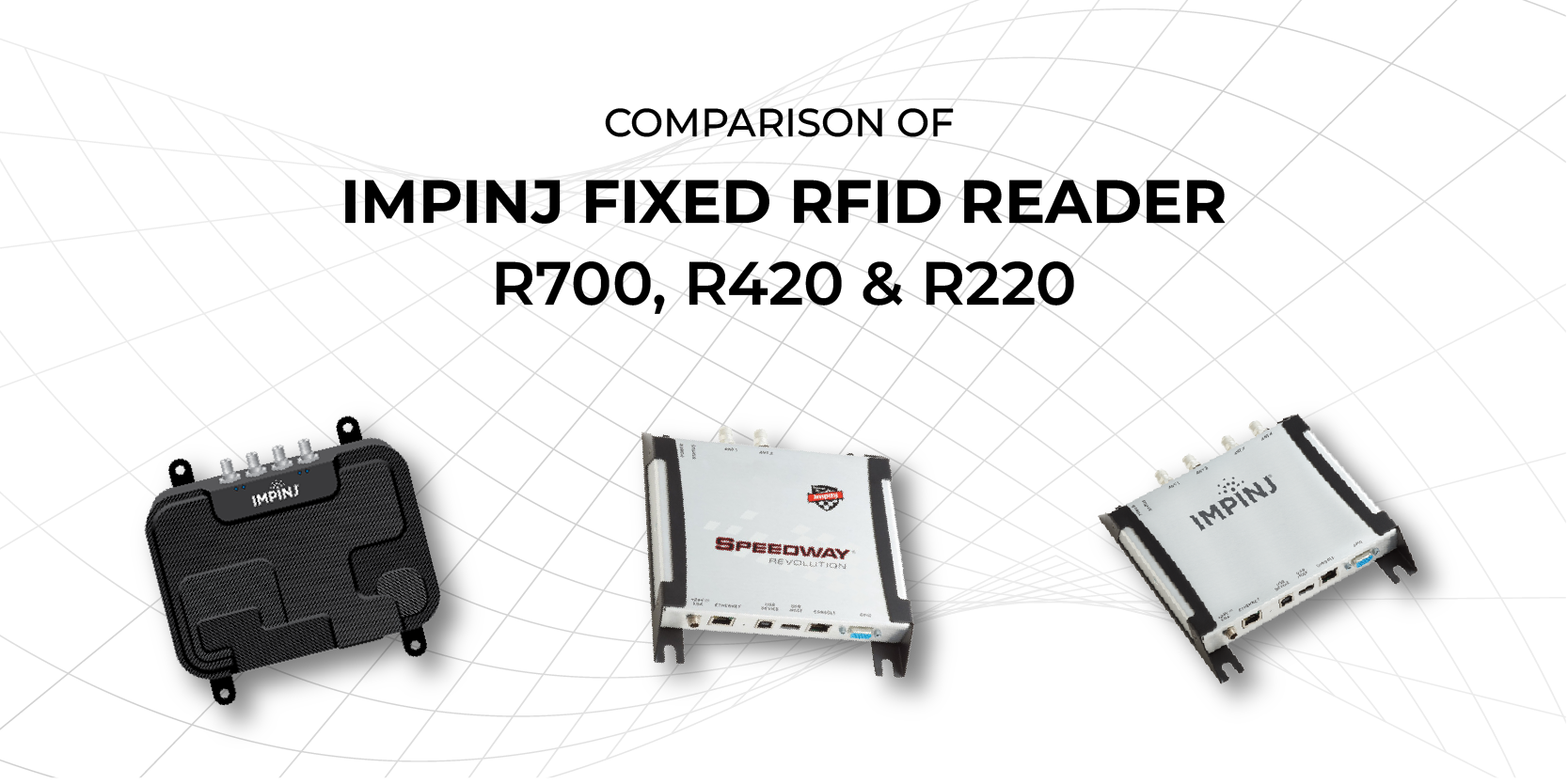
In this detailed comparison, we’ll explore the key features, strengths, and best use cases for each model, helping you select the ideal Impinj fixed RFID reader for your application.
Quick Overview of Impinj Fixed Readers Lineup
Here’s a quick snapshot of where each model stands:
|
Model |
Target Audience |
Positioning |
Ideal For |
|
R700 |
Enterprise/IoT |
Flagship |
High-volume, real-time applications |
|
R420 (Speedway Revolution) |
Mature installations |
Workhorse |
Mid-large warehouses, distribution |
|
R220 (Speedway Revolution) |
Entry-level |
Budget-friendly |
Small deployments, startups |
Impinj R700 - Next-Gen Enterprise Reader
The Impinj R700 is Impinj’s most advanced fixed RFID reader to date. It is designed to meet the demands of modern enterprise environments that require high tag throughput, real-time data capture, and seamless integration with IoT platforms. The R700 is ideal for businesses that want to future-proof their RFID infrastructure.
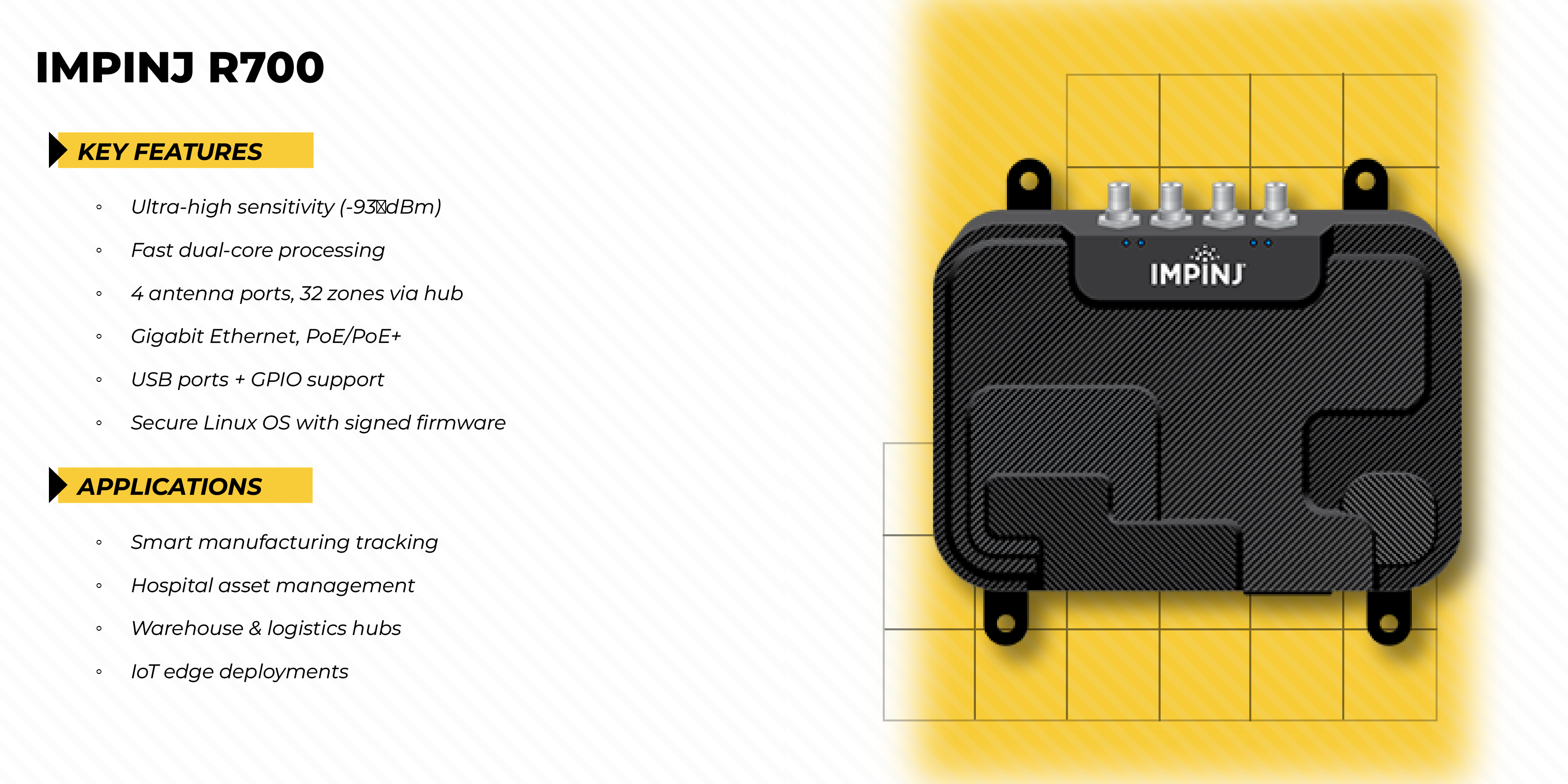
Key Features & Specifications
Superior Sensitivity: The R700 delivers industry-leading receive sensitivity of up to -92 dBm, ensuring highly reliable tag reads even in dense tag populations and complex RF environments. Its advanced RF performance makes it ideal for demanding, high-volume applications.
Edge Processing: Built-in processing capabilities allow real-time filtering, aggregation, transformation, and event publishing of tag data directly on the device using the Impinj IoT Device Interface (IDI). This reduces latency, minimizes backend system load, and supports real-time decision-making at the edge.
Modern APIs: The R700 supports modern integration protocols, including RESTful API, MQTT, and HTTPS, enabling seamless integration with cloud platforms and IoT systems. It also maintains backwards compatibility with Low Level Reader Protocol (LLRP), offering flexibility for both modern and legacy systems.
High-Speed Connectivity: The device features a Gigabit Ethernet interface (10/100/1000 Mbps) for high-speed data transfer. Power options include Power over Ethernet (PoE, IEEE 802.3af) and PoE+ (IEEE 802.3at), simplifying installation and eliminating the need for separate power cabling.
Security: Advanced security features include Secure Boot and digitally signed firmware, ensuring that only authorized firmware updates can be installed. Secure remote firmware updates further enhance system integrity and protect against unauthorized changes.
Additional Specifications:
- Antenna Ports: 4 monostatic ports with reverse polarity TNC connectors
- Transmit Power: 33 dBm max (PoE+), 30 dBm max (PoE)
- Operating Frequency: 902–928 MHz (FCC) / 865–868 MHz (ETSI); global SKU available
- GPIO: 4 inputs / 4 outputs for external device integration
- Operating Temperature: -4° F to 122° F (-20° C to 50° C)
- Dimensions: 195 mm x 165 mm x 34 mm
- Weight: ~1.27 kg
- Enclosure: Durable aluminium housing
The Impinj R700 offers exceptional read sensitivity and speed, making it ideal for large-scale enterprise deployments that demand high-performance RFID operations. Its modern IoT integration capabilities and advanced features make it a future-proof investment.
Use Cases
Real-time retail inventory management (omnichannel fulfilment):
Provides instant inventory visibility across retail locations, enabling accurate stock levels, faster restocking, online order fulfillment, and seamless omnichannel operations, improving customer satisfaction and reducing out-of-stock scenarios.
Smart manufacturing & Industry 4.0:
Supports automated material tracking, production line monitoring, and predictive maintenance by integrating with IoT systems, enhancing operational efficiency, reducing downtime, and ensuring accurate component traceability throughout manufacturing processes.
Healthcare asset tracking & pharmaceutical compliance:
Tracks medical equipment, medications, and critical supplies in real-time, ensuring regulatory compliance, reducing errors, improving patient safety, and optimizing resource utilization in hospitals, labs, and pharmaceutical storage.
Logistics hubs with high tag density:
Handles dense tag environments with high-speed, accurate reads for inbound/outbound processing, inventory control, and shipment verification, enabling efficient supply chain operations and minimizing shipping errors.
Impinj Speedway R420 - Proven Industry Workhorse
The Speedway R420 has long been the industry standard for reliable RFID reading. Known for its rock-solid stability and performance, it has powered thousands of deployments across various industries, including warehousing, logistics, healthcare, and manufacturing, for over a decade.
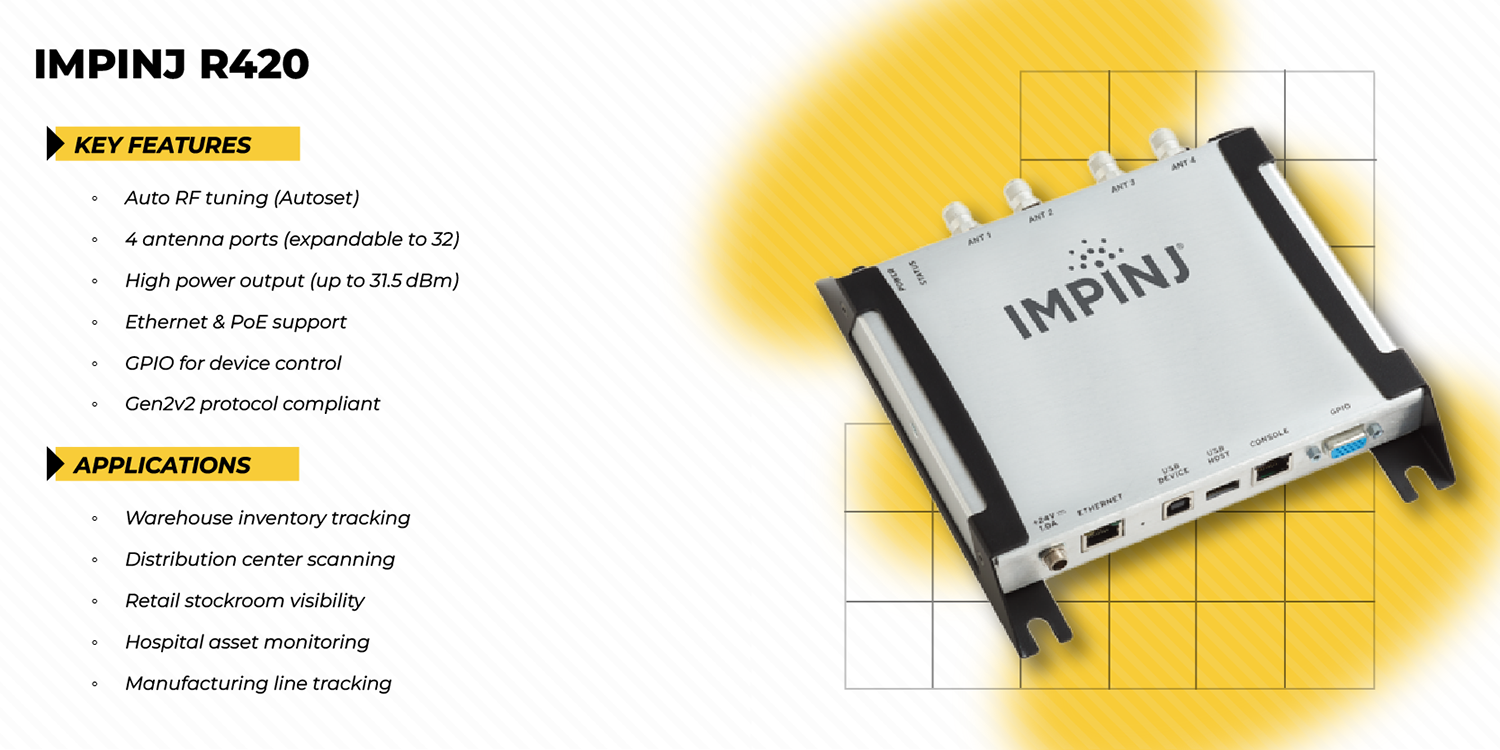
Key Features & Specifications
Dynamic Environment Adaptation: The R420 features Autoset technology that automatically tunes RF parameters in real-time to compensate for environmental changes such as interference, material movement, or tag density variations. This ensures consistently optimal read performance in dynamic and challenging environments.
Multiple Antenna Ports: Equipped with 4 monostatic antenna ports, the R420 supports flexible read zone configurations. Users can create broad coverage areas, monitor multiple zones simultaneously, and enable effective multi-directional scanning for complex deployments.
EPCglobal Gen 2v2 Support: Fully compliant with EPCglobal Gen 2v2 standards, the R420 ensures seamless interoperability with a wide variety of UHF RFID tags and systems across multiple industries. It supports secure, reliable tag reading and advanced Gen2 features such as tag authentication.
GPIO & External Device Control: The R420 includes GPIO ports that enable integration with external hardware such as lights, alarms, sensors, or gates. This allows real-time automation and control based on RFID read events, enhancing operational workflows and process automation.
Additional Specifications:
- RF Power Output: Up to 31.5 dBm (adjustable)
- Receive Sensitivity: Up to -84 dBm
- Frequency Range: 865–868 MHz (ETSI), 902–928 MHz (FCC), global SKU options available
- Protocols Supported: EPCglobal UHF Class 1 Gen 2 / ISO 18000-6C
- Power Options: Power over Ethernet (PoE), AC adapter
- GPIO: 4 inputs / 4 outputs for device control and automation
- Security: Basic password protection, LLRP-based communication
- Operating Temperature: -20 °C to +50 °C (-4° to +122°F)
- Dimensions: 190 mm x 191 mm x 28 mm
- Weight: ~1.1 kg
- Enclosure: Aluminum housing, IP52 rated (limited protection against dust and water)
Use Cases
Distribution centers and warehouses: Efficiently manage high-volume goods movement, real-time inventory visibility, and automated inbound/outbound processing, improving order accuracy, reducing labour costs, and optimizing supply chain operations.
Hospital inventory management: Tracks medical equipment, surgical tools, and consumables in real-time, ensuring proper stock levels, reducing asset loss, enhancing patient safety, and supporting regulatory compliance across hospital departments.
Backroom and stockroom retail operations: Provides accurate inventory tracking in storage areas, ensuring timely replenishment to sales floors, minimizing stockouts, improving merchandising accuracy, and enabling efficient backroom-to-sales-floor transfers.
Airport baggage tracking: Enables real-time luggage tracking from check-in to arrival, reducing lost baggage incidents, improving passenger experience, and streamlining airport baggage handling processes for greater efficiency and accountability.
Pros and Cons
The Impinj R420 is a battle-tested reader proven in real-world environments, offering flexible deployment options and strong compatibility with many existing middleware systems. However, it lacks modern IoT integration like REST or MQTT, processes data slower compared to newer models like the R700, and may face end-of-life considerations for enterprises seeking long-term future-proofing.
Impinj Speedway R220 - Cost-Effective Solution
The Speedway R220 is a cost-effective version of the R420, offering a simplified feature set for smaller deployments or businesses just beginning their RFID journey. While it shares the core reading technology of the R420, it’s more affordable and easier to configure.
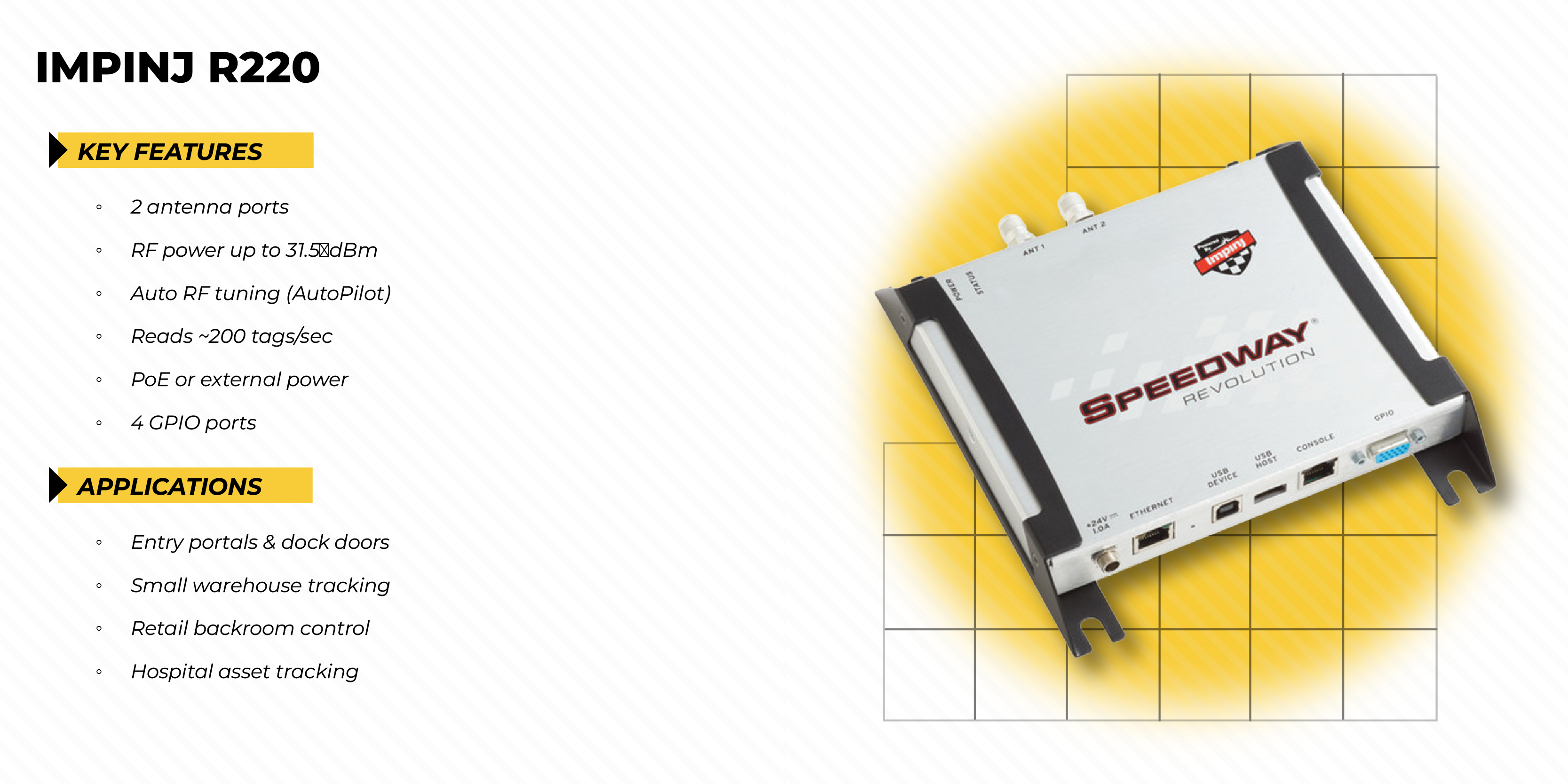
Key Features & Specifications
2 Antenna Ports: Comes with 2 RP-TNC antenna ports, ideal for simple and focused read zones such as dock doors, stockrooms, or shelf monitoring. Supports monostatic configuration.
Same RF Performance as R420: Utilizes the same core Impinj Indy R2000 reader chip as the R420, delivering high read sensitivity and reliability in dense tag environments.
Lower Total Cost of Ownership: Designed for cost-effective deployments with fewer features, making it easier to install, configure, and maintain for smaller-scale applications.
GPIO Support: Equipped with 4-input / 4-output GPIO ports, allowing integration with basic external devices such as light stacks, buzzers, or door sensors.
RF Power Output: Adjustable output power from +10 dBm to +31.5 dBm in 0.5 dB steps to suit varying environmental and range requirements.
Network & Power: Includes Ethernet connectivity and supports Power over Ethernet (PoE, IEEE 802.3af Class 3), eliminating the need for separate power wiring.
Protocol Compatibility: Fully compliant with EPCglobal UHF Gen 2 (ISO 18000-6C) standard, ensuring compatibility with a wide range of RFID tags.
Form Factor: Compact design with aluminium enclosure; supports VESA mounting and fits well in space-constrained environments.
Operating Temperature: Operates reliably in industrial settings with a range of 0°C to +50°C.
Use Cases
Small retail stores or boutiques: Ideal for tracking high-value items in compact spaces, enabling real-time inventory accuracy and shrinkage prevention in smaller retail environments with minimal antenna requirements.
IT Office asset tracking: Used to monitor laptops, files, and IT equipment within corporate offices, helping streamline audits, reduce loss, and enhance asset visibility with minimal setup.
Limited coverage warehouse: Efficient for small storage zones or low-volume processing areas where basic RFID read zones are sufficient and large-scale infrastructure is unnecessary.
Rental equipment tracking: Perfect for tracking outgoing and returned rental assets like tools, electronics, or uniforms, ensuring item accountability and accurate inventory in low-footprint environments.
Pros and Cons
The Impinj Speedway R220 offers reliable read performance for smaller environments, making it easy to deploy and maintain. However, its scalability is limited, with fewer integration options, and it may face end-of-life considerations, posing challenges for enterprises seeking long-term, future-proof solutions.
Deep Technical Comparison Table: R700, R420, and R220
|
Specification |
Impinj R700 |
Impinj Speedway R420 |
Impinj Speedway R220 |
|
Antenna Ports |
4 × RP‑TNC, monostatic |
4 × RP‑TNC (expandable to 32 via hubs) |
2 × RP‑TNC |
|
Transmit Power |
PoE+: 10–33 dBm; PoE: 10–30 dBm |
FCC: 32.5 dBm (AC) / 31.5 dBm (PoE); EU: 31.5 dBm/30 dBm |
FCC/EU: up to 31.5 dBm (PoE/AC) |
|
Receive Sensitivity |
Typical: –92 dBm (CISC 90%) |
Ideal: –87 dBm; Typical/Challenging: –84 dBm |
Same as R420 (–84 dBm typical) |
|
Max Read Rate |
Up to ~1100 tags/sec |
Up to 1100 tags/sec |
Approximately 200 tags/sec |
|
RF Protocol |
EPCglobal UHF Gen2v2 / ISO 18000‑63 |
EPCglobal UHF Gen2 / ISO 18000‑6C |
EPCglobal UHF Gen2 / ISO 18000‑6C |
|
Power & Network |
Gigabit Ethernet (10/100/1000), PoE/PoE+ with LLDP |
Ethernet 10/100 Mbps, PoE (802.3af), optional AC power |
Ethernet 10/100 Mbps, PoE (802.3af), AC power |
|
GPIO / I/O |
2 inputs / 3 outputs, USB 3×Type-A + micro USB |
GPIO inputs/outputs, 1 × USB, RS-232 |
GPIO 4 in/4 out, basic USB support |
|
Operating Temperature |
–20 °C to +50 °C |
–20 °C to +50 °C (–4 °F to +122 °F) |
–20 °C to +50 °C |
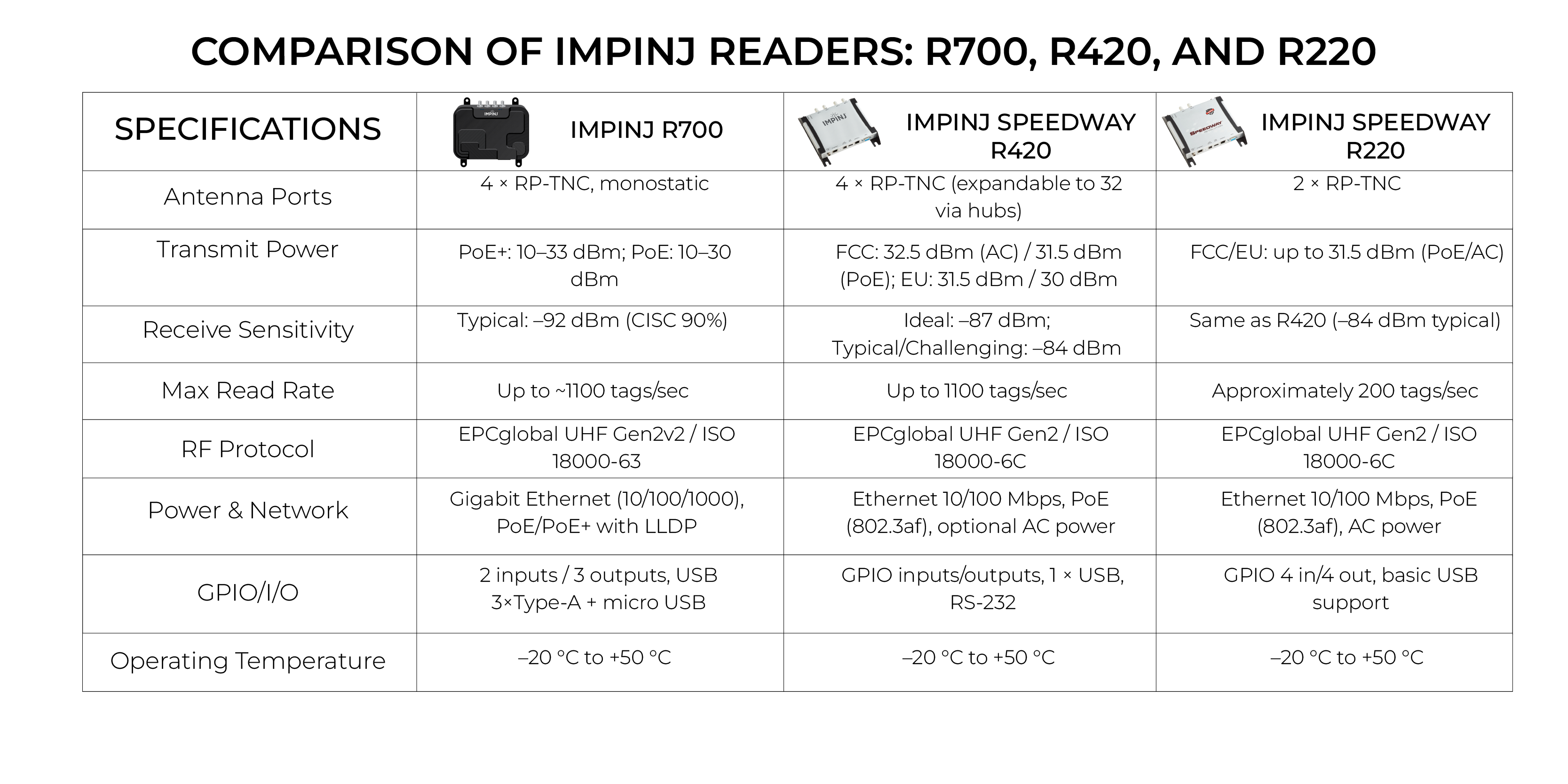
How to Choose the Right Impinj Fixed Reader?
When selecting an Impinj fixed reader, consider:
Integration Needs: If your application demands seamless integration with cloud platforms, IoT systems, or modern enterprise tools, the R700 is the ideal choice. It supports RESTful API, MQTT, and modern communication protocols.
Tag Density & Read Volume: For environments with high tag volumes or fast-moving items—such as large warehouses, logistics hubs, or manufacturing facilities—the R700 delivers superior read sensitivity and speed for accurate, real-time tracking.
Budget: The R220 is a cost-effective entry-level option suited for basic RFID applications. It offers reliable performance for small-scale deployments without the need for advanced features.
Future-Proofing: The R700 offers modern connectivity, secure firmware capabilities, and flexible integration options, making it a smart long-term investment for evolving business and technology needs.
Conclusion
Impinj’s fixed RFID readers cover a wide range of use cases—from simple retail or office tracking to advanced, real-time inventory management in enterprise environments. The R700 stands out as a powerful, future-ready solution with modern software compatibility. The R420 continues to be a reliable industry workhorse for standard warehouse needs, while the R220 is perfect for small-scale, budget-conscious deployments.
Choosing the right reader depends on your current operational scale, performance requirements, and integration environment. If you're planning to implement or upgrade your RFID system, connect with an RFID expert to find the ideal fit for your needs.
FAQ Section
What is the difference between Impinj R700 and R420 readers?
The R700 offers superior sensitivity, modern API support, and edge processing, while the R420 is a proven, reliable reader with older integration options.
Which Impinj RFID reader is best for high-density tag environments?
The Impinj R700 is best suited for dense tag environments due to its industry-leading sensitivity and high read performance.
Is the Impinj R220 suitable for small-scale RFID deployments?
Yes, the R220 is a cost-effective option designed for simple RFID applications like small retail stores or basic asset tracking.
Recent Posts
-
How RFID Anti-Theft Tags Revolutionize the Retail Industry
Introduction Retail theft and inventory shrinkage are challenges that every store owner faces. Wheth …Dec 22nd 2025 -
RFID Portals in Manufacturing: Tracking Work-in-Progress Efficiently
Introduction Manufacturing thrives on precision and timing. Every part, component, and subassembly m …Dec 15th 2025 -
RF Shielding Explained: Types, Applications, and Benefits
Introduction RF shielding is essential for protecting devices from electromagnetic interference. Thi …Dec 8th 2025

